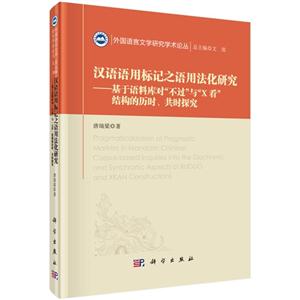扫一扫
关注中图网
官方微博
本类五星书更多>
-
>
妙相梵容
-
>
基立尔蒙文:蒙文
-
>
我的石头记
-
>
心灵元气社
-
>
女性生存战争
-
>
县中的孩子 中国县域教育生态
-
>
(精)人类的明天(八品)
买过本商品的人还买了
汉语语用标记之语用法化研究-基于语料库对不过与X看结构的历时.共时探究 版权信息
- ISBN:9787030448347
- 条形码:9787030448347 ; 978-7-03-044834-7
- 装帧:一般胶版纸
- 册数:暂无
- 重量:暂无
- 所属分类:>
汉语语用标记之语用法化研究-基于语料库对不过与X看结构的历时.共时探究 内容简介
本研究依托古代、现代汉语语料库,通过对"不过"与"X看"两个案的研究探讨了汉语语用标记的历史形成过程。"不过"与"X看"这两个结构*初只是作为非语用性质的动词词组,随着时间的推移,进而演变为具有篇章语用功能的语用标记。本书有两个主要目的:1)探讨"不过"与"X看"结构的篇章语用变化是如何发生的,以及为何会产生这种历史变化;2)证明语用标记的演变非语法化范畴。通过历时探究,本书认为语用标记以及其他相似语言成分的历史形成过程属于语用法化(pragmaticalization)范畴。语用法化与语法化是两种不同的语言演变过程。
汉语语用标记之语用法化研究-基于语料库对不过与X看结构的历时.共时探究 目录
contents
丛书序i
前言iii
chapter one introduction1
1.1 rationale for the present research5
1.2 state of the art and problems9
1.2.1 previous researches on diachronic evolution of buguo and xkan9
1.2.2 previous researches on synchronic aspects of buguo and xkan13
1.2.3 why diachronic?16
1.2.4 interim summary22
1.3 diachronic work relevant to this book24
1.3.1 grammaticalization24
1.3.2 pragmaticalization31
1.3.3 models of semantic change36
1.4 data and methodology46
1.4.1 values of corpus-based research46
1.4.2 the data47
1.4.3 methodology for the analysis50
1.5 objectives of the present study52
1.6 outline of the book55
chapter two pragmatic functions of buguo: a synchronic analysis57
2.1 data and methodology59
2.2 use and functional distribution of buguo in the corpus60
2.3 pragmatic functions of buguo63
2.3.1 metalinguistic functions63
2.3.2 metacommunicative functions72
2.4 the relationship between the core meaning of buguo and its pragmatic functions82
chapter three pragmaticalization of buguo: a diachronic analysis87
3.1 data, distribution of buguo and methodology88
3.2 main meanings of guo91
3.3 historical development of buguo93
3.3.1 buguo in old chinese94
3.3.2 buguo in middle chinese107
3.3.3 buguo in old mandarin111
3.3.4 buguo in middle mandarin119
3.4 pragmaticalization of buguo124
3.5 motivations and mechanisms involved in the pragmaticalization of buguo127
3.5.1 motivations for the pragmaticalization of buguo127
3.5.2 mechanisms of the pragmaticalization of buguo135
3.6 accompanying changes of the pragmaticalization of buguo148
3.6.1 phonological changes148
3.6.2 semantic changes149
3.6.3 syntactic changes152
chapter four pragmatic functions of xkan: a synchronic analysis154
4.1 data and methodology155
4.2 xkan: pm use vs. non-pm use156
4.3 use and distribution of wokan and nikan in the corpus160
4.4 pragmatic functions of wokan164
4.4.1 self-quotation164
4.4.2 wokan as a hesitation marker170
4.5 pragmatic functions of nikan174
4.5.1 nikan as an attention getter176
4.5.2 nikan as a coherence builder178
4.5.3 nikan as a politeness marker182
4.5.4 nikan as a turn yielder184
4.6 xkan as markers of interpersonal involvement186
4.6.1 “involvement” in the present study186
4.6.2 discussion188
chapter five pragmaticalization of xkan: a diachronic analysis190
5.1 distribution of wokan and nikan and methodology191
5.2 core meanings of kan192
5.3 historical development of xkan194
5.3.1 historical development of wokan194
5.3.2 historical development of nikan206
5.4 pragmaticalization of xkan218
5.5 motivations and mechanisms involved in the pragmaticalization of xkan221
5.5.1 motivations for the pragmaticalization of xkan221
5.5.2 mechanisms of the pragmaticalization of xkan226
5.6 accompanying changes of the pragmaticalization of xkan234
5.6.1 phonological changes234
5.6.2 semantic changes235
5.6.3 syntactic changes236
chapter six historical development of buguo and xkan: cases of pragmaticalization238
6.1 traditional interpretation of the rise of pragmatic markers239
6.2 historical evidence from the evolution of buguo and xkan as pragmatic markers244
6.2.1 grammar vs. pragmatics244
6.2.2 discussion249
6.3 pragmaticalization reconsidered265
6.3.1 relationship between pragmaticalization and grammaticalization265
6.3.2 a morpheme-based approach to pragmaticalization268
chapter seven conclusion270
7.1 review270
7.2 directions for future study276
references279
appendix: a brief chronology of chinese history295
list of figures
figure 1.1 evolution line of buguo in shen’s research10
figure 1.2 model of the iitsc40
figure 2.1 functional distribution of buguo82
figure 3.1 buguo1 in the pre-qin period98
figure 3.2 a sketch of the historical development of buguo125
figure 3.3 functional change in buguo’s pragmaticalization126/272
figure 3.4 general representation of the image schema of guo130
figure 3.5 representation of the image schema of spatial guo130
figure 3.6 representation of the image schema of temporal guo131
figure 3.7 representation of the image schema of guo followed by abstract concept133
figure 3.8 representation of the image schema of standard guo134
figure 3.9 the iitsc model in the semantic shift of buguo’s pragmaticalization from buguo1 to buguo2140
figure 3.10 semantic changes of buguo151
figure 3.11 syntactic changes of buguo152
figure 5.1 semantic-pragmatic functions of wokan in middle mandarin199
figure 5.2 discursive behaviors of nikan in the southern song dynasty and the yuan dynasty211
figure 5.3 functional change in wokan’s pragmaticalization219/273
figure 5.4 functional change in nikan’s pragmaticalization220/273
figure 5.5 semantic shifts of kan in xkan’s pragmaticalization222
figure 5.6 invited inferencing in xkan’s pragmaticalization231
figure 5.7 semantic changes of xkan235
figure 5.8 syntactic changes of xkan236
figure 6.1 pragmaticalization of buguo and unidirectionality262
figure 6.2 pragmaticalization of xkan and unidirectionality263
figure 6.3 clines of pragmaticalization266
list
丛书序i
前言iii
chapter one introduction1
1.1 rationale for the present research5
1.2 state of the art and problems9
1.2.1 previous researches on diachronic evolution of buguo and xkan9
1.2.2 previous researches on synchronic aspects of buguo and xkan13
1.2.3 why diachronic?16
1.2.4 interim summary22
1.3 diachronic work relevant to this book24
1.3.1 grammaticalization24
1.3.2 pragmaticalization31
1.3.3 models of semantic change36
1.4 data and methodology46
1.4.1 values of corpus-based research46
1.4.2 the data47
1.4.3 methodology for the analysis50
1.5 objectives of the present study52
1.6 outline of the book55
chapter two pragmatic functions of buguo: a synchronic analysis57
2.1 data and methodology59
2.2 use and functional distribution of buguo in the corpus60
2.3 pragmatic functions of buguo63
2.3.1 metalinguistic functions63
2.3.2 metacommunicative functions72
2.4 the relationship between the core meaning of buguo and its pragmatic functions82
chapter three pragmaticalization of buguo: a diachronic analysis87
3.1 data, distribution of buguo and methodology88
3.2 main meanings of guo91
3.3 historical development of buguo93
3.3.1 buguo in old chinese94
3.3.2 buguo in middle chinese107
3.3.3 buguo in old mandarin111
3.3.4 buguo in middle mandarin119
3.4 pragmaticalization of buguo124
3.5 motivations and mechanisms involved in the pragmaticalization of buguo127
3.5.1 motivations for the pragmaticalization of buguo127
3.5.2 mechanisms of the pragmaticalization of buguo135
3.6 accompanying changes of the pragmaticalization of buguo148
3.6.1 phonological changes148
3.6.2 semantic changes149
3.6.3 syntactic changes152
chapter four pragmatic functions of xkan: a synchronic analysis154
4.1 data and methodology155
4.2 xkan: pm use vs. non-pm use156
4.3 use and distribution of wokan and nikan in the corpus160
4.4 pragmatic functions of wokan164
4.4.1 self-quotation164
4.4.2 wokan as a hesitation marker170
4.5 pragmatic functions of nikan174
4.5.1 nikan as an attention getter176
4.5.2 nikan as a coherence builder178
4.5.3 nikan as a politeness marker182
4.5.4 nikan as a turn yielder184
4.6 xkan as markers of interpersonal involvement186
4.6.1 “involvement” in the present study186
4.6.2 discussion188
chapter five pragmaticalization of xkan: a diachronic analysis190
5.1 distribution of wokan and nikan and methodology191
5.2 core meanings of kan192
5.3 historical development of xkan194
5.3.1 historical development of wokan194
5.3.2 historical development of nikan206
5.4 pragmaticalization of xkan218
5.5 motivations and mechanisms involved in the pragmaticalization of xkan221
5.5.1 motivations for the pragmaticalization of xkan221
5.5.2 mechanisms of the pragmaticalization of xkan226
5.6 accompanying changes of the pragmaticalization of xkan234
5.6.1 phonological changes234
5.6.2 semantic changes235
5.6.3 syntactic changes236
chapter six historical development of buguo and xkan: cases of pragmaticalization238
6.1 traditional interpretation of the rise of pragmatic markers239
6.2 historical evidence from the evolution of buguo and xkan as pragmatic markers244
6.2.1 grammar vs. pragmatics244
6.2.2 discussion249
6.3 pragmaticalization reconsidered265
6.3.1 relationship between pragmaticalization and grammaticalization265
6.3.2 a morpheme-based approach to pragmaticalization268
chapter seven conclusion270
7.1 review270
7.2 directions for future study276
references279
appendix: a brief chronology of chinese history295
list of figures
figure 1.1 evolution line of buguo in shen’s research10
figure 1.2 model of the iitsc40
figure 2.1 functional distribution of buguo82
figure 3.1 buguo1 in the pre-qin period98
figure 3.2 a sketch of the historical development of buguo125
figure 3.3 functional change in buguo’s pragmaticalization126/272
figure 3.4 general representation of the image schema of guo130
figure 3.5 representation of the image schema of spatial guo130
figure 3.6 representation of the image schema of temporal guo131
figure 3.7 representation of the image schema of guo followed by abstract concept133
figure 3.8 representation of the image schema of standard guo134
figure 3.9 the iitsc model in the semantic shift of buguo’s pragmaticalization from buguo1 to buguo2140
figure 3.10 semantic changes of buguo151
figure 3.11 syntactic changes of buguo152
figure 5.1 semantic-pragmatic functions of wokan in middle mandarin199
figure 5.2 discursive behaviors of nikan in the southern song dynasty and the yuan dynasty211
figure 5.3 functional change in wokan’s pragmaticalization219/273
figure 5.4 functional change in nikan’s pragmaticalization220/273
figure 5.5 semantic shifts of kan in xkan’s pragmaticalization222
figure 5.6 invited inferencing in xkan’s pragmaticalization231
figure 5.7 semantic changes of xkan235
figure 5.8 syntactic changes of xkan236
figure 6.1 pragmaticalization of buguo and unidirectionality262
figure 6.2 pragmaticalization of xkan and unidirectionality263
figure 6.3 clines of pragmaticalization266
list
展开全部
书友推荐
- >
罗庸西南联大授课录
罗庸西南联大授课录
¥14.1¥32.0 - >
上帝之肋:男人的真实旅程
上帝之肋:男人的真实旅程
¥20.2¥35.0 - >
巴金-再思录
巴金-再思录
¥15.7¥46.0 - >
月亮与六便士
月亮与六便士
¥19.1¥42.0 - >
史学评论
史学评论
¥14.4¥42.0 - >
伯纳黛特,你要去哪(2021新版)
伯纳黛特,你要去哪(2021新版)
¥16.9¥49.8 - >
回忆爱玛侬
回忆爱玛侬
¥24.0¥32.8 - >
龙榆生:词曲概论/大家小书
龙榆生:词曲概论/大家小书
¥8.7¥24.0
本类畅销
-
咬文嚼字大赛场
¥12.2¥35 -
说文解字-影印本
¥13.2¥38 -
中国人的名·字·号
¥10¥28 -
《标点符号用法》解读
¥10.8¥15 -
汉字细说·第一辑
¥20.5¥65 -
梁晓声人生感悟-我最初的故乡是书箱
¥12.3¥42
浏览历史
受载岩石应力波传播与动态疲劳力学特性
¥85.3¥108.0风暴潮灾害风险评估技术方法体系构建与实证研究
¥57.2¥78.0农作物监测的多源遥感数据分析与应用
¥81.0¥108.0天数(博尔赫斯全集)//2022新定价
¥27.9¥42.0民国文人系列:一片云彩——民国文人归宿
¥25.5¥68.0


















